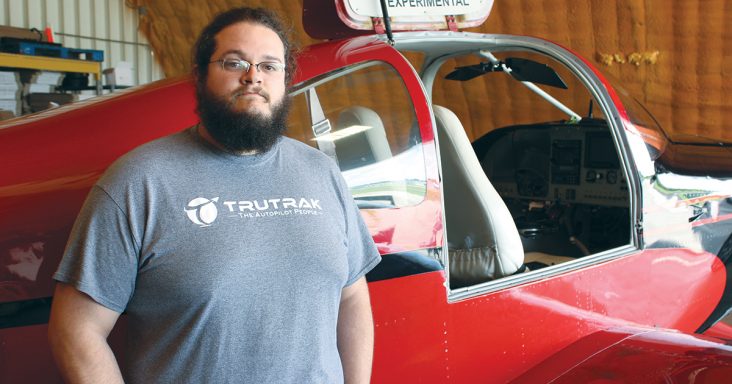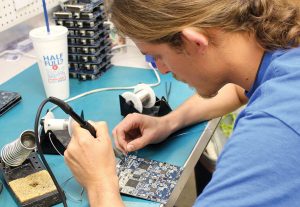TruTrak expanding to new facility, adding more staff
by September 20, 2018 5:39 pm 1,704 views

Moss Foster, general manager for TruTrak Flight Systems, was head engineer before he became manager in 2017. The self-taught engineer has written the code for the autopilot systems.
In 1999, TruTrak Flight Systems Inc. was established in Springdale and started selling autopilot systems for experimental aircraft.
When the company started selling the systems for certified aircraft in 2017, it had about a dozen employees. By summer 2019, owner Andrew Barker said the business is expected to nearly double in size, after adding up to 10 positions.
TruTrak plans to accommodate the growth by building a 12,000- to 16,000-square-foot building on leased city land a few blocks north of its existing location along the east side of the runway at Springdale Municipal Airport. The new building will be at least two times larger and hold nearly double the number of employees.
“Our current growth is rather uncontrolled at this point,” general manager Moss Foster said. “We’re trying to add jobs as quickly as we can train people. But we are out of space for extra people at this point.”
While the expansion is still being planned, the estimated investment is between $1 million and $2 million. Construction is expected to start this fall, with hopes to move in this spring, Foster said. Along with adding more staff, a new facility will allow the company to install more test stations and reduce production bottlenecks.
“We can’t meet the volume requirements right now for demand,” Foster said. “We’re hoping to meet that.”
TruTrak has been in a 6,000-square-foot building at 1488 S. Old Missouri Road for about 14 years, after moving from a building to the south that was about half the size.
TAX BACK PROGRAM
The Springdale City Council recently endorsed TruTrak to participate in Arkansas’ Tax Back program, which provides tax rebates of up to 5.5% on a company’s expansion costs.
“It’s exciting to see the success of a homegrown company like TruTrak Flight Systems,” said Scott Edmondson, vice president of economic development for the Springdale Chamber of Commerce. “The investment in their new facility and new job creation will certainly help bolster Springdale’s economy. This is a great example of the chamber working together with a local company to identify ways to grow.”

Foster explained that the rebates could save the company between $50,000 and $100,000. Also, the company is participating in Advantage Arkansas, which provides income tax credits based on the number of new full-time employees it adds as a result of the expansion.
Brandi Hinkle, director of communications for the Arkansas Economic Development Commission, said the state agency has worked with TruTrak on the incentive programs since May. Companies that invest at least $100,000 into an expansion are eligible to receive the Tax Back program. Advantage Arkansas is open to companies that create full-time jobs with wages of at least $11.60 per hour. The tax credits through the program can be used to offset taxes over a five-year period.
Foster said the company also is hoping to apply for a tax back program through Washington County.
RISING SALES
The company sells its autopilot systems from its location and to installers and dealers. It has an online store, and nearly 90% of its business is in the United States. It sells between 500 and 750 systems annually, and sales have risen between 20% and 30% each year. Revenue is expected to rise more than 25% annually over the next two to three years.
Certified aircraft account for nearly 75% of the company’s business, with the remainder being experimental aircraft. Since TruTrak entered the certified market last summer, the Federal Aviation Administration has approved its autopilot systems to be installed in seven certified aircraft.
“The certified market itself is, total volume’s about five to six times bigger,” Foster said. “There’s a bit of a vacuum in our price range and availability for some of the older aircraft as retrofits. People have been very anxious to do something.”
The company’s autopilot systems cost $5,000, which does not include installation. The Vizion autopilot system is the company’s most popular system for the certified market. Foster said the cost to install a system varies, but a nearby installer charges less than $2,000 to install one. And with a certified airplane, the system must be installed professionally. Owners can install their own autopilot system in an experimental airplane.
It takes between eight and 16 hours to build an autopilot system, and the company looks to adds between two and three models to its product line each year. It has five existing models of autopilot systems and has plans to modify an existing model in order for it to be installed into Mooney airplanes. It should be available in about three months, Foster said.
There are about five manufacturers worldwide that produce similar autopilot systems, and TruTrak’s biggest competitor is Garmin, Foster said. Some of the company’s competitors are based in the Washington area. None are in Arkansas.
Recently, Barker was awarded the Freedom of Flight Award, the highest honor that the Experimental Aircraft Association bestows. The award recognizes affordable avionics, and Barker received the award along with Robert Hamilton, president of Dynon Avionics.
“Honestly, I was really shocked,” Barker said. “It was really neat to be recognized for following my passion.”
He’s worked at TruTrak since 2000 and became partner eight years ago. He’s owned the company for four years.
